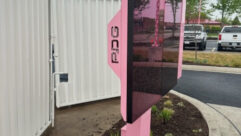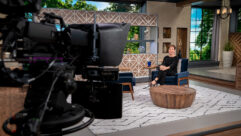INSTALL OF THE MONTH
Nov 1, 2003 12:00 PM,
Gregory DeTogne
Having been described variously as “MTV meets the YMCA” and “the ultimate teen hang,” Rocketown has just about everything young people could want except for bad influences. Founded by Christian-music recording artist Michael W. Smith, the fully renovated club reopened in the heart of downtown Nashville earlier this year, occupying what used to be known as the Wesco Building, a one-time electrical warehouse on Sixth Avenue South. Featuring an indoor skate park, a cybercafe, and a fine-arts gallery, the venue also includes a world-class nightclub served by Funktion-One loudspeaker arrays powered by PowerLight and PowerLight 2 Series amplifiers from QSC.
A positive and safe place for young people to enjoy entertainment and recreation relevant to their age group and the times, Rocketown was originally opened by Smith in 1994 at another site in Franklin, Tennessee. For three years, the club was successful at that location, and then the lease ran out. “We looked at probably three dozen buildings along the way,” Rocketown Director of Youth Services Shawn Hedegard told The Nashville Rage in early January, describing the long road back to the club’s reopening. “We looked at this one in March [2002] and knew it was the place. The vibe is absolutely perfect. It feels like it was built 75 years ago just for our needs.”
In a town full of nightspots, Rocketown’s nightclub promises to be one of the best in its class. “It fits into its own unique niche here,” says Carl Taylor of Q, the firm responsible for systems design and integration within the space. “There’s really no other room like it around town. On one end of the spectrum, we have venues like 328 Performance Hall, which holds about 300 people, and on the other, we have the Ryman Auditorium, which has a capacity of about 1,800. There has never been anything in between, until now.”
Working from its Nashville offices, the Q design/build team furnished Rocketown’s nightclub/dance environment with a dual-purpose audio rig built to accommodate both live and recorded program material. Inspired by a touring design Q developed late in 2002 for Amy Grant, the system relies upon four flown, cornermounted Funktion-One full-range loudspeaker arrays and a collection of ground-dwelling Funktion-One low-frequency cabinets powered by a single PowerLight 6.0 from QSC, a pair of PowerLight 4.0s, three PowerLight 2 224s, and eight PowerLight 236s.
Rocketown project manager Eric Elwell (a seasoned audio pro who serves as the regular front-of-house [FOH] engineer for Smith’s live shows) was also the man responsible for shepherding the Q-created Amy Grant rig around the country last fall. “That was his first chance to mix on what is essentially the same system we’ve installed at Rocketown,” Taylor says. “With the Rocketown rig, however, we effectively married live sound principles with the analytical disciplines of modeling and acoustics employed in the consulting world.”
Using data gathered with EASE 4.0 as a starting point, Q conducted further testing in the room, which clearly established the locations of resonant frequencies and other acoustical problems. With treatments added as necessary to ward off the negative impact of standing waves and other sonic gremlins, the environment took on sonorous characteristics not usually associated with its harsh, reflective concrete-and-brick construction.
“It’s come a long way from what it was in its previous life,” Taylor says of the space. “Now it has a real stage, a real sound system, and moving lights. When they’re not going at it full tilt on the dance floor, all kinds of acts are booked, and the room hosts private functions, as well. That’s why we designed the audio system to handle anything that may come through the doors.”
A dbx 480 drive rack supplies processing for the system, which can be quickly converted from dance use to live performance by simply selecting one of two presets. Other outboard processing kept at hand includes a K-T graphic at FOH and a multi-effects box from TC Electronic. To facilitate house mixing, a custom 54-pair snake feeds a 32-channel Soundcraft Spirit LX7 console taking up permanent residence at FOH.
For the DJ booth, which is located high above the dance floor in a gallery on the second level, the Q design team chose a Pioneer CDJ-1000 CD player, Technics 1200 turntables, and a top-of-the-line rotary-knob DJ mixer from Rane.
“This is very much a live performance room,” Taylor says. “But now that it’s done, I’d say it’s equally suited to dance applications, as well. The Funktion-One loudspeakers are extremely versatile; we use them for churches, corporate events, and just about everything else, too. As for the QSC amplifiers on the power end of the equation, we’ve conducted exhaustive A/B listening tests with these and other amps, and QSC wins hands down every time. A lot of people contend that horsepower is just horsepower, but amplifiers do make a big difference in how sound ultimately comes out of a loudspeaker.”
Rocketown officially opened to the public on January 10 with a concert by GRITS, a Grammy-nominated hip-hop group. If all goes according to plans, the venue will serve as a model for others slated to be built around the country.
“If you open a new movie theater in Hollywood, it has to be good, because expectations are high, and everyone will be your critic when you’re done,” Taylor says. “The same holds true for constructing a music venue in Nashville. The whole world is watching and listening, so there’s absolutely no room for excuses.”
Subscribe to S&VC EXTRA!
Breaking industry news in your e-mail inbox every other week! Subscribe at www.svconline.com.









